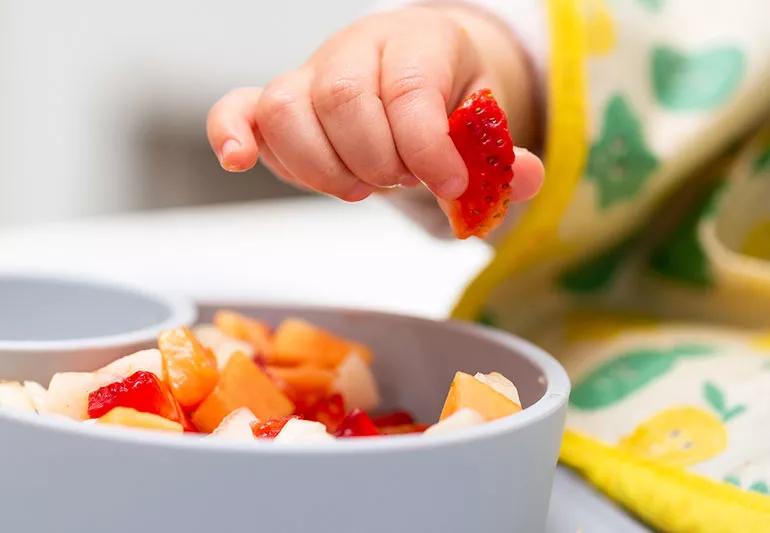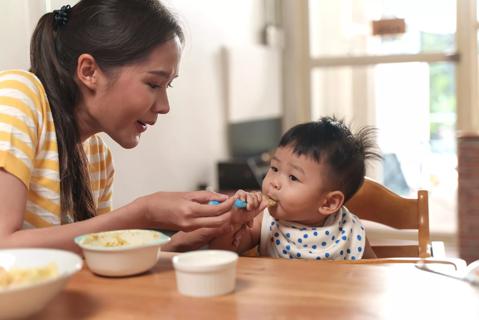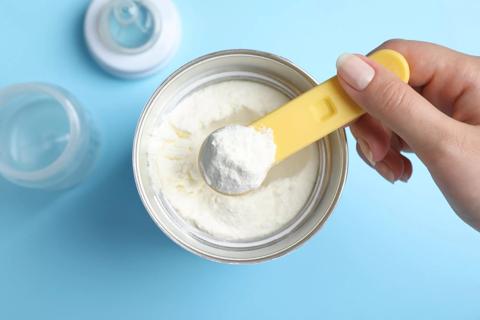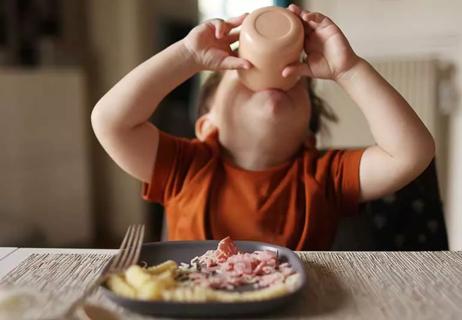An easy guide to healthy foods for kids

It’s an Instagram-worthy moment in the making: The day your baby first tries solid food — and smears it all over everything in (and out of) sight. But what comes next?
Cleveland Clinic is a non-profit academic medical center. Advertising on our site helps support our mission. We do not endorse non-Cleveland Clinic products or services. Policy
“Toddlerhood is prime time for growth spurts and brain development, so we want to make sure to give them the best nutrition possible,” says pediatric dietitian Jennifer Hyland, RD, CSP, LD.
Hyland shares her top five toddler food tips to help set them up for a lifetime of healthy eating.
When should you lay the groundwork for that first foray into toddler finger foods? When they are babies. “Introduce a variety of foods in infancy,” says Hyland. “Start offering age-appropriate foods at about 6 months, and wait a couple of days between the introduction of each new food.”
Try different food groups and textures, including meats, dairy (closer to age 1) and healthy fats. That way, your baby is used to different foods — and flavors — by the time they reach toddlerhood.
“The volume of a child’s milk intake should go down after their first birthday, so they have more room for solid foods,” Hyland explains. “If kids are still chugging an 8-ounce bottle at every meal, they tend to eat less.”
Transitioning from a bottle to a cup will help reduce the milk consumption so that they take in a more reasonable 4 to 6 ounces of liquid at a time.
Cut toddler snacks into safe-to-eat-sized pieces to reduce the risk of choking. Hyland recommends keeping that knife active until around age 4.
But the term “bite-sized” no longer means chunks. “We now recommend cutting things into strips,” she notes. “A child’s windpipe is around the size of a pinky finger. Cut food into little pieces of strips that are thinner than that, so it can easily pass through the throat if your child accidentally swallows it whole.”
That advice goes for round foods as well, such as grapes and cherry tomatoes. Cut them lengthwise for safe snacking.
Long gone are the days of forcing your kid to “clean their plate.” Instead, embrace small portion sizes for their much smaller bodies.
“A tablespoon per age is a good starting point,” says Hyland. “For toddler-sized portions, think two to three crackers, a half a slice of bread, a few bites of chicken or a half to one whole egg.”
If you feel your kids aren’t eating enough, remember that they don’t have to eat a whole plate of broccoli. “Two to three pieces is fine for their age,” she says.
Try, try again. Hyland says it can take more than 20 times for your novice eater to accept a new food or flavor. “Even if they don’t eat them, continue to introduce healthy foods.”
To minimize thrown plates and screeches of “NO,” make eating interactive and fun. Let your child help pick out foods at the grocery store or stir when you cook.
And when your toddler suddenly refuses to eat an old favorite, don’t panic or get frustrated. Toddler food jags are perfectly normal and come in waves. If you stay the course, your little one will be back to downing peas in no time.
Hyland’s rule of thumb for toddler snacks? “Offer your kids anything and everything that you eat. It doesn’t need to be a perceived toddler food.” She recommends covering all the basic food groups, including:
Offer both well-cooked and raw veggies regularly. Broccoli, carrots, green beans and zucchini are all good options to cook. Raw vegetables should be soft-ish, easy to chew and swallow, and cut thinly, such as skinless and seedless cucumbers or bell peppers, cut appropriately.
Offer a variety of soft fruits, preferably fresh. Be cautious of added sugar in applesauce and fruit pouches and choose unsweetened options instead.
Good quality fat is especially important for brain development in 1- and 2-year-olds. Healthy fats are also good for your toddler’s heart.
Avocado is a great healthy fat to start with since it’s soft. “And early introduction to nut butters is recommended from an allergy standpoint. They are also a great source of healthy fat,” says Hyland. “Try a very thin layer of peanut butter on a piece of bread or cracker, or you can mix or melt peanut butter or almond butter into oatmeal and similar foods.”
Healthy oils that you cook with, such as olive oil, count, too. So does milk. “Most young toddlers can get much of the fat they need from whole milk. Older toddlers — like 2- and 3-year-olds — can transition to low-fat milk and still get a lot of the health benefits,” she says.
The sky’s the limit when it comes to whole grains, which include whole-wheat bread, oatmeal, quinoa and well-cooked pasta. “I would even put potatoes in the grain category, so potatoes or sweet potatoes are great,” Hyland says. “Mash them or cut them into skinny strips and roast them.”
Make sure the protein is cut appropriately. Try ground meats, flaky fish, and scrambled or hard-boiled eggs. If you’re a vegetarian, you could offer tofu strips, hummus or mashed-up beans.
Not all foods are considered toddler-safe, even in bite-sized strips. Don’t feed your toddler:
Learn more about our editorial process.

In babies under 12 months, honey may cause a serious illness called infant botulism

When breastfeeding doesn’t go as planned, you may need to supplement with formula or donor breast milk — and that’s OK

Typically, milk comes in a few days after birth and regulates around four weeks after delivery

Look for snacks that are low in sugar and high in fiber, protein and healthy fats

No amount of caffeine is safe for kids under 12, and kids 12 to 17 should be cautious about how much they consume

They aren’t unhealthy, but they’re probably a waste of money

Tiny kidneys and tiny tummies don’t mix well with water

Cut up foods into small pieces and make sure you sit down and focus during meals

Your metabolism may torch 1,300 to 2,000 calories daily with no activity

A gentle touch in all the right places may help drain your sinuses